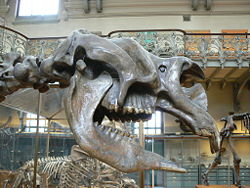
Back ديبروتودون Arabic Diprotodon optatum Catalan Diprotodon Czech Diprotodon German Diprotodon English Diprotodon Spanish Diprotodon Basque دیپروتودون Persian Diprotodon Finnish Diprotodon French
| Diprotodon Temporal range: Pleistocene
| |
|---|---|

| |
| Scientific classification | |
| Kingdom: | |
| Phylum: | |
| Class: | |
| Infraclass: | |
| Order: | |
| Suborder: | |
| Family: | |
| Genus: | Diprotodon Owen, 1838
|
Diprotodon was the largest marsupial that ever lived, or at any rate, the heaviest. Its family, the Diprotodontidae, existed from at least 1.6 million years ago until extinction some 40,000 years ago.[1] So it lived through most of the Pleistocene epoch. Its forebears lived in the late Oligocene to early Miocene roughly 23 million years ago.
Diprotodon looked like a rhino without a horn. Its feet turned inwards like a wombat’s, giving it a pigeon-toed appearance. It had strong claws on the front feet, so it may have been able to dig up roots to eat. Footprints of its hairy feet have been found, so we know it had fur like a horse rather than being bald like a rhino. Diprotodon is found in sites all over Australia, but not in Tasmania.
Female skeletons have been found with babies where the mother's pouch would have been.[2] The largest specimens were hippopotamus-sized: about 3 metres (9.8 ft) from nose to tail, standing 2 metres (6.6 ft) tall at the shoulder and weighing about 2,790 kilograms (6,150 lb).[3]
The animal was semi-aquatic with a life-style rather like a hippo. Its extinction may have been caused by the extreme drought conditions, as well as pressure from the first Aboriginal Australians.
- ↑ Roberts R.G. et al 2002. (2001). "New ages for the last Australian megafauna: continent-wide extinction about 46,000 years ago" (PDF). Science. 292 (5523): 1888–1892. Bibcode:2001Sci...292.1888R. doi:10.1126/science.1060264. PMID 11397939. S2CID 45643228. Retrieved 26 August 2011.
{{cite journal}}: CS1 maint: numeric names: authors list (link) - ↑ "Science & Nature: Animals: Diprotodon". Official website. British Broadcasting Corporation (BBC). July 2008. Retrieved 24 February 2011.
- ↑ Ice age marsupial topped three tons, scientists say. Retrieved 17 September 2003.